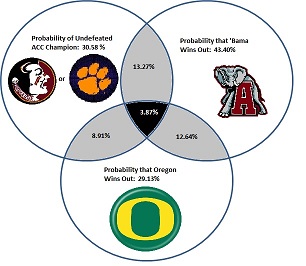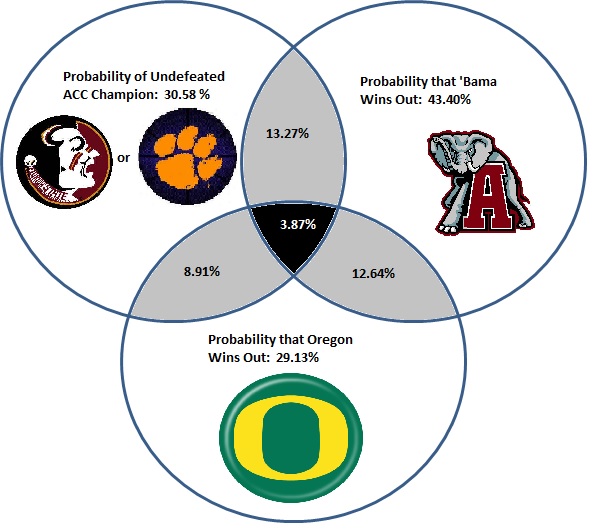 Buckeye Archive
Buckeye Archive  Playing the Odds: Does an Undefeated Ohio State Team make the NCG?
Playing the Odds: Does an Undefeated Ohio State Team make the NCG?

Whether or not an undefeated Ohio State team gets into the BCS National Championship Game has become one of the hottest topics on college football message boards. At this point in the season there are typically a mess of undefeated teams and anxiety starts building about which teams will get left out.
This point is especially poignant for Ohio State fans because the Buckeyes started the season ranked #2 and firmly in control of their own destiny, but an uninspiring win in Week One over Buffalo immediately dropped the Buckeyes to #3 and growing support for Clemson pushed the Tigers above Ohio State to #4 in the AP the following week. Although the AP has nothing to do with crowning a BCS National Champion, the slip in the rankings was an alarm that national perception of this Ohio State team was losing traction.
The B1G is obviously down this year, and as such, it is making Ohio State much more likely to win out, but it is also much more likely to be passed by teams that have accomplished more than beating everyone in a bad league. Right now you have to assume that an undefeated or one loss SEC champion is in, and an undefeated PAC 12 or ACC champion is in regardless of current ranking. Louisville is unlikely to pass an undefeated Ohio State team in the polls, and I doubt that the undefeated teams in the Big XII are likely to gain the necessary poll traction to pass Ohio State regardless of the outcome of their games. The computers, which will hate Ohio State, have significant (1/3rd of the BCS Ranking) say in the final rankings, but the humans polls (Harris and Coaches), which control the majority of that ranking, will have a hard time looking past 25 consecutive wins.
This mess of undefeated teams typically takes care of itself as the season wears on simply because it is hard to win all of your games, even against a weak schedule since even low probability events (upsets) have a way of occurring given a large enough number of trials. Assume for a moment that a team is an overwhelming favorite in every game all season long to the extent that they would beat each opponent on their schedule 19 out of 20 times. The likelihood of that team actually winning all of its games is surprisingly only 54%. No team is ever actually that likely to win all of their games, so the odds of any team going undefeated are actually much lower.
To make this point I made suppositions about each team’s likelihood to win each of its remaining games, and built it into a spreadsheet about two weeks ago and it looked like this:

The conclusion of that eye chart was that Ohio State and Alabama were the only teams that enjoyed greater than a 50:50 shot at finishing out undefeated due to weak remaining schedules. Alabama really only had one difficult game remaining, LSU, and Ohio State’s most difficult remaining games were at Northwestern and at Michigan. This model also predicted that there would be a blood-letting in the ACC which makes sense because FSU and Clemson have to play each other. It also predicted, correctly, that Stanford was very unlikely to survive undefeated to the PAC 12 Conference Championship Game. Surprisingly, Georgia looked to have a pretty clear path to the SEC CCG, but that was before their warts and injuries started mounting during the Tennessee game.
The week of 12 October was the first real upset weekend, and we saw three teams effectively bow out of consideration. That is not to say that their seasons are over, but simply that they are now statistically, very unlikely to vault an undefeated Ohio State team.

The picture above is now much clearer. Ohio State’s probability of winning enjoyed a significant surge because they won one of their two most difficult remaining games at Northwestern and Stanford and Georgia’s unlikely losses have removed two possibilities. Staring down the probabilities, it still appears likely that the ACC champion will lose at least one game due to the difficult remaining schedules and Oregon still has significant work to do just to make it to the PAC 12 CCG. UCLA’s impressive recent play also bears watching in the coming weeks and they will be added to this model if they knock off Oregon on 26 October. I still think it is unlikely that the Bruins would vault an undefeated Ohio State team, but this situation would bear (pun intended) watching.
I believe that the Conference Championship Game format significantly assists Ohio State and the winner of the Clemson vs. FSU game. Upsets still occur, but Ohio State and the ACC Atlantic winner are likely to be big favorites. Nebraska and MSU have the inside track on the CCG from the Legends Division because neither has to play Ohio State, whereas one loss Michigan is likely to gain at least a second loss from Ohio State. The ACC Atlantic Champ is likely to meet an overmatched Miami or Virginia Tech in their CCG.
The winner of the Oregon/Stanford game appears likely to draw a rematch against a pretty good UCLA team, and it is hard to beat any team twice in the same season, particularly a good one.
It is still pretty hard to get a feel for which team will emerge from the congested mess that is the top of the SEC East. I think ‘Bama is still likely to beat the team that emerges, but there is a lot of football to go over there.

The grey areas in the diagram above represent the regions in which two of the three events that cause Ohio State to get left behind occur, effectively those represent the spaces where Ohio State is not in control of its own destiny. For the sake of this diagram, I assumed that each team was likely to win its conference c championship game three times out of four (75%).
The overall probability that Ohio State is not in control of its own destiny: 27.09%
The overall probability that Ohio State ends in the NCG (assumes 85% winning CCG): 38.62%
If you would like a copy of this spreadsheet to change the win-loss assumptions and determine your own odds of an OSU NCG, email me at furlan.mike@gmail.com.
- NBA Announces 2013-2014 Schedule
- Browns Ink Sharknado
- Sharknado A No-Show For Rookie Camp
- Trent Richardson Out Until Training Camp
- Browns Sign Brandon Jackson
- Carrasco Suspended Eight Games
- Browns Add to Wide Receiver Depth with David Nelson
- Browns Need to Learn from Past Draft Mistakes
- Browns Release Chris Gocong and Usama Young
- Browns Missing on Grimes Disappointing, But Not The End
The TCF Forums
- Official- Browns Coach Search/Rumors
HoodooMan (Tuesday, January 21 2014 1:32 PM) - Movies coming out
rebelwithoutaclue (Tuesday, January 21 2014 12:56 PM) - 2015 Recruiting
jclvd_23 (Tuesday, January 21 2014 12:38 PM) - The 2014 Offseason Thread
Larvell Blanks (Tuesday, January 21 2014 12:25 PM) - Chris Grant's first 3 drafts
Kingpin74 (Tuesday, January 21 2014 10:13 AM) - Mike Brown
YahooFanChicago (Monday, January 20 2014 11:15 PM) - 2014 Hoops Hockey Hijinx
jpd1224 (Monday, January 20 2014 4:44 PM) - 2014 Recruiting
jclvd_23 (Monday, January 20 2014 2:26 PM) - Wish List - #4 Pick
Hikohadon (Monday, January 20 2014 1:26 PM) - #1 overall pick Anthony Bennett
TouchEmAllTime (Sunday, January 19 2014 1:28 PM)



